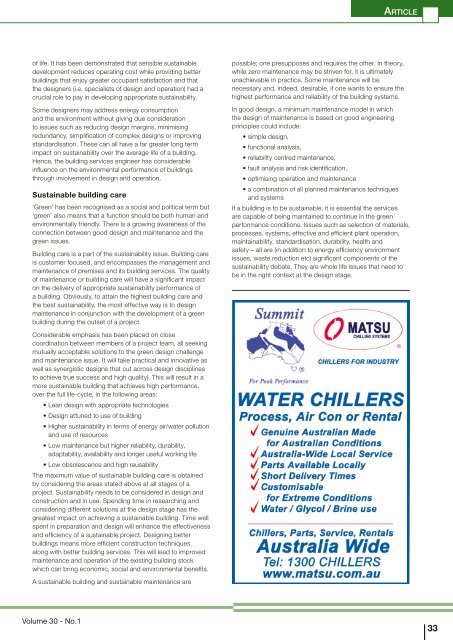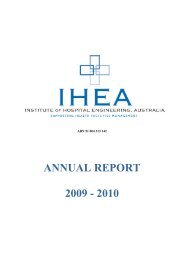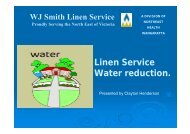Design for maintenance from the viewpoint of sustainable hospital ...
Design for maintenance from the viewpoint of sustainable hospital ...
Design for maintenance from the viewpoint of sustainable hospital ...
Create successful ePaper yourself
Turn your PDF publications into a flip-book with our unique Google optimized e-Paper software.
Ar t i cl e<br />
<strong>of</strong> life. It has been demonstrated that sensible <strong>sustainable</strong><br />
development reduces operating cost while providing better<br />
buildings that enjoy greater occupant satisfaction and that<br />
<strong>the</strong> designers (i.e. specialists <strong>of</strong> design and operation) had a<br />
crucial role to pay in developing appropriate sustainability.<br />
Some designers may address energy consumption<br />
and <strong>the</strong> environment without giving due consideration<br />
to issues such as reducing design margins, minimising<br />
redundancy, simplification <strong>of</strong> complex designs or improving<br />
standardisation. These can all have a far greater long term<br />
impact on sustainability over <strong>the</strong> average life <strong>of</strong> a building.<br />
Hence, <strong>the</strong> building services engineer has considerable<br />
influence on <strong>the</strong> environmental per<strong>for</strong>mance <strong>of</strong> buildings<br />
through involvement in design and operation.<br />
Sustainable building care<br />
‘Green’ has been recognised as a social and political term but<br />
‘green’ also means that a function should be both human and<br />
environmentally friendly. There is a growing awareness <strong>of</strong> <strong>the</strong><br />
connection between good design and <strong>maintenance</strong> and <strong>the</strong><br />
green issues.<br />
Building care is a part <strong>of</strong> <strong>the</strong> sustainability issue. Building care<br />
is customer focused, and encompasses <strong>the</strong> management and<br />
<strong>maintenance</strong> <strong>of</strong> premises and its building services. The quality<br />
<strong>of</strong> <strong>maintenance</strong> or building care will have a significant impact<br />
on <strong>the</strong> delivery <strong>of</strong> appropriate sustainability per<strong>for</strong>mance <strong>of</strong><br />
a building. Obviously, to attain <strong>the</strong> highest building care and<br />
<strong>the</strong> best sustainability, <strong>the</strong> most effective way is to design<br />
<strong>maintenance</strong> in conjunction with <strong>the</strong> development <strong>of</strong> a green<br />
building during <strong>the</strong> outset <strong>of</strong> a project.<br />
possible; one presupposes and requires <strong>the</strong> o<strong>the</strong>r. In <strong>the</strong>ory,<br />
while zero <strong>maintenance</strong> may be striven <strong>for</strong>, it is ultimately<br />
unachievable in practice. Some <strong>maintenance</strong> will be<br />
necessary and, indeed, desirable, if one wants to ensure <strong>the</strong><br />
highest per<strong>for</strong>mance and reliability <strong>of</strong> <strong>the</strong> building systems.<br />
In good design, a minimum <strong>maintenance</strong> model in which<br />
<strong>the</strong> design <strong>of</strong> <strong>maintenance</strong> is based on good engineering<br />
principles could include:<br />
• simple design,<br />
• functional analysis,<br />
• reliability centred <strong>maintenance</strong>,<br />
• fault analysis and risk identification,<br />
• optimising operation and <strong>maintenance</strong><br />
• a combination <strong>of</strong> all planned <strong>maintenance</strong> techniques<br />
and systems<br />
If a building is to be <strong>sustainable</strong>, it is essential <strong>the</strong> services<br />
are capable <strong>of</strong> being maintained to continue in <strong>the</strong> green<br />
per<strong>for</strong>mance conditions. Issues such as selection <strong>of</strong> materials,<br />
processes, systems, effective and efficient plant operation,<br />
maintainability, standardisation, durability, health and<br />
safety – all are (in addition to energy efficiency environment<br />
issues, waste reduction etc) significant components <strong>of</strong> <strong>the</strong><br />
sustainability debate. They are whole life issues that need to<br />
be in <strong>the</strong> right context at <strong>the</strong> design stage.<br />
Considerable emphasis has been placed on close<br />
coordination between members <strong>of</strong> a project team, all seeking<br />
mutually acceptable solutions to <strong>the</strong> green design challenge<br />
and <strong>maintenance</strong> issue. It will take practical and innovative as<br />
well as synergistic designs that cut across design disciplines<br />
to achieve true success and high quality). This will result in a<br />
more <strong>sustainable</strong> building that achieves high per<strong>for</strong>mance,<br />
over <strong>the</strong> full life-cycle, in <strong>the</strong> following areas:<br />
• Lean design with appropriate technologies<br />
• <strong>Design</strong> attuned to use <strong>of</strong> building<br />
• Higher sustainability in terms <strong>of</strong> energy air/water pollution<br />
and use <strong>of</strong> resources<br />
• Low <strong>maintenance</strong> but higher reliability, durability,<br />
adaptability, availability and longer useful working life<br />
• Low obsolescence and high reusability<br />
The maximum value <strong>of</strong> <strong>sustainable</strong> building care is obtained<br />
by considering <strong>the</strong> areas stated above at all stages <strong>of</strong> a<br />
project. Sustainability needs to be considered in design and<br />
construction and in use. Spending time in researching and<br />
considering different solutions at <strong>the</strong> design stage has <strong>the</strong><br />
greatest impact on achieving a <strong>sustainable</strong> building. Time well<br />
spent in preparation and design will enhance <strong>the</strong> effectiveness<br />
and efficiency <strong>of</strong> a <strong>sustainable</strong> project. <strong>Design</strong>ing better<br />
buildings means more efficient construction techniques<br />
along with better building services. This will lead to improved<br />
<strong>maintenance</strong> and operation <strong>of</strong> <strong>the</strong> existing building stock<br />
which can bring economic, social and environmental benefits.<br />
A <strong>sustainable</strong> building and <strong>sustainable</strong> <strong>maintenance</strong> are<br />
Volume 30 - No.1<br />
33
















